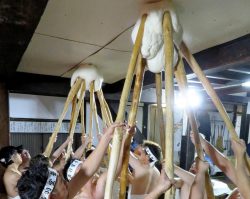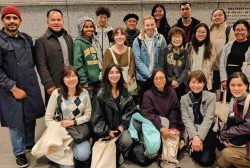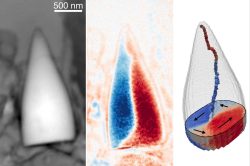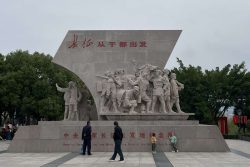1 Month after Noto Peninsula Earthquake: Provide Road Map for Rebuilding Region / Generous Support Vital for Long Evacuation
16:09 JST, February 1, 2024
It has been one month since the Noto Peninsula Earthquake struck. The damage has been enormous and reconstruction will take a long time. It is important to sort out the issues to be addressed, rank them by priority and resolve them one by one.
Initially, the most important issues were to rescue disaster victims and open evacuation centers. Later, secondary evacuations to locations outside the affected areas began and schools were reopened.
Still unresolved is the suspension of running water. Water pipes ruptured in many places, and the water supply is still cut off for much of the affected areas. Local government officials and others from all over the country are assisting in the restoration work, but some areas are not expected to get running water back until April or later.
Work hard to provide water supply
Disaster victims have been forced to get their daily water from water stations set up at evacuation centers and elsewhere, and to store river water to wash clothes and flush toilets. Aware of the need to save water, some people are hesitant to brush their teeth or wash their hands, increasing their risk of contracting infectious diseases.
A growing number of disaster victims are reportedly returning to their damaged homes because they are tired of living together in evacuation centers. The elderly and others have trouble carrying heavy water tanks to their homes. It is essential to strengthen support through such measures as water tank trucks making frequent rounds.
Many evacuees are hoping to move into temporary housing, as many houses have collapsed. However, there is little flat land available for construction in the affected areas, and the start of work has been delayed. Ishikawa Gov. Hiroshi Hase has referred to the construction of two-story temporary housing to more efficiently get victims into homes.
It is hoped that the parties concerned will consider ways to overcome the situation, such as local governments renting private apartments and other facilities as deemed temporary housing.
Roads have been severed and therefore the removal of collapsed houses is still not progressing as fast as expected. It is also difficult for volunteers to enter the affected areas, which is a major reason for the delay in rebuilding.
It is necessary to look back over the past month and closely examine what issues still remain. It is hoped that a reconstruction plan will be drawn up from a medium- to long-term perspective, with the headquarters for restoration and recovery support established by the central government playing a central role.
Disaster victims, including those who have taken shelter at the homes of relatives and acquaintances, have evacuated over a scattered area. Efforts must be made to understand the situation of each person to prevent isolation and the non-receipt of support. It is also necessary to devise ways to ensure that communications between local governments and residents, and exchanges between residents, are not disrupted.
Restore local industries, culture
The earthquake has also had a devastating impact on Noto’s local industries. The question going forward will be how to support businesses as they try to restart.
In the fishing industry, many ports have been damaged by seafloor upheaval, and the ensuing tsunami capsized and sank a number of boats. The season for yellowtail has arrived, but ice-making machines have been rendered inoperable by the quake, so to keep up shipments, ice is being transported from Kanazawa and elsewhere.
The affected coastal areas also cultivate oysters and sell them under the brand name “Noto kaki,” but their oyster racks have been severely damaged. The economic loss, including for squid fisheries, is immeasurable.
In Wajima’s traditional industry of lacquerware, most production and sales bases collapsed or burned down due to the impact of the earthquake and the fire that spread through the central parts of the city. Many business operators — including living national treasures, who are formally called holders of important intangible cultural property — have been affected by the disaster.
The forestry, livestock, sake brewing and tourist industries have also been severely damaged.
The central government has announced a support package to help businesses restore their facilities and revitalize traditional industries, among other aims.
The government said it will also start a travel discount program for tourism in the Hokuriku region to stimulate tourist demand. It is important to steadily implement these support measures.
Even before the quake, the affected areas were aging and their populations were shrinking. Without a clear, concrete picture of how the areas will be rebuilt, the anxiety of residents will only grow.
The central and local governments need to think about how to revitalize the affected areas going forward. It is hoped that they will explore ways to help people live safely, and to enable the areas’ industries, tourism and culture to be more vibrant than before.
In Japan, which has been struck by major disasters many times in the past, new technologies and ideas have been developed to cope with damage from disasters.
In the wake of disasters such as the 2018 torrential rain in western parts of Japan, a simplified shower has been developed that can purify water from swimming pools and other sources and reuse it over and over again. In the latest quake, too, the showers have been brought to the affected areas, where they were widely appreciated by many evacuees.
Utilize past knowledge
At the proposal of Kumamoto city officials who had experienced the 2016 Kumamoto Earthquake, camper vans have been used as accommodations for municipal officials who rushed to the affected areas from all over Japan to offer their support.
The areas in and around the Noto Peninsula are enduring the coldest period of the winter. It is essential to make the utmost use of such knowledge to alleviate, even if only slightly, the hardships experienced by people living in severe conditions as evacuees.
(From The Yomiuri Shimbun, Feb. 1, 2024)
"Editorial & Columns" POPULAR ARTICLE
-

Corporate Interim Earnings: Companies Must Devise Ways to Overcome Trump Tariffs
-

Violations of Subcontract Law: Major Automakers Must Eliminate Old Practices
-

Local Governments’ Tax Revenues: Devise Ways to Correct Imbalances in Tax Sources
-

Takaichi’s Summit with Economics-Minded Trump Successfully Advanced Japan’s Security Interests
-

Lower House Budget Committee: Unrestrained Fiscal Stimulus Is Unacceptable
JN ACCESS RANKING
-

Govt Plans to Urge Municipalities to Help Residents Cope with Rising Prices
-

Japan Prime Minister Takaichi Vows to Have Country Exit Deflation, Closely Monitor Economic Indicators
-

Japan to Charge Foreigners More for Residence Permits, Looking to Align with Western Countries
-

Essential Services Shortage to Hit Japan’s GDP By Up to ¥76 Tril. By 2040
-

Japan GDP Down Annualized 1.8% in July-Sept.


















